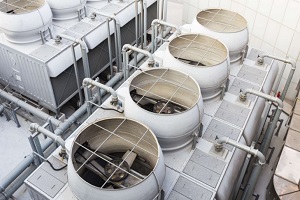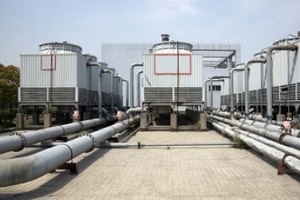 Cooling towers are essential for many industrial processes and buildings, as they help maintain the required temperature and humidity levels.
Cooling towers are essential for many industrial processes and buildings, as they help maintain the required temperature and humidity levels.
The following are some of the most frequently asked questions about cooling towers to help you better understand their functions, benefits and maintenance requirements.
What Are The Benefits Of A Cooling Tower Over Air Cooling?
Cooling towers have a significant advantage over air cooling systems due to their higher efficiency. Cooling with water is 3,200 times more efficient than cooling with air. This can be attributed to water’s higher heat capacity and ability to absorb and dissipate heat more effectively than air.
As a result, cooling towers can achieve the desired temperature levels with less energy consumption. This leads to cost savings on the operational and environmental fronts.
What Should Be The Difference Between Supply & Return Temperatures?
The cooling range is the temperature difference between the hot water entering the cooling tower (supply temperature) and the cooled water leaving the cooling tower (return temperature). This difference represents the heat the cooling tower removes from the process or system.
The ideal cooling range depends on the specific application and design of the cooling tower. However, a cooling range between 10 to 15 degrees Fahrenheit (5.5 to 8.3 degrees Celsius) is typical for most applications. A higher cooling range implies that the cooling tower effectively removes more heat from the water, leading to more efficient cooling.
One should carefully plan the cooling range during the design phase to ensure that the cooling tower is the right size and can handle the required heat load.
How Do You Know A Cooling Tower Is Sized Correctly & Can Handle The Load?
Several factors need to be considered to determine if a cooling tower is the correct size and can handle the required load. These include the cooling range, flow rate, and wet bulb temperature.
 The flow rate is the amount of water circulating through the system. The wet bulb temperature is the lowest temperature achievable through evaporative cooling.
The flow rate is the amount of water circulating through the system. The wet bulb temperature is the lowest temperature achievable through evaporative cooling.
Engineers can use these parameters to calculate and match the required cooling capacity with the cooling tower’s specifications. If the cooling tower’s capacity is equal to or greater than the required capacity, it is appropriately sized.
It is essential to consult with an experienced engineer or cooling tower manufacturer to ensure the selected cooling tower is suitable for the specific application.
Contact The Water Treatment Pros
To learn more about Tower Water's services reach out today!
What Are The Most Important Maintenance Tasks For My Cooling Tower?
Proper maintenance is critical for the efficient operation of a cooling tower. Some of the most fundamental maintenance tasks include:
Filtration
Regularly inspect and clean the tower’s filters, as they help keep debris and contaminants out of the system. Clogged filters can reduce the tower’s efficiency and increase the risk of corrosion and scaling.
Water Treatment Equipment & Service
Implement a comprehensive water treatment program to control microbial growth, scale formation and corrosion. These include:
- Regularly inspecting water treatment equipment
- Monitoring water quality
- Adjusting chemical treatment as necessary
Legionella Testing
Regularly test for Legionella bacteria in the cooling tower’s water. Legionnaires’ disease, a severe form of pneumonia that can sometimes be fatal, is caused by the Legionella bacteria. Implementing a proper water treatment program and keeping the cooling tower clean can help prevent Legionella growth.
How Does A Cooling Tower Help Me Save On Water & Energy?
Cooling towers can contribute to significant water and energy savings by utilizing the evaporative cooling process. The remaining water cools by evaporating a small portion of the circulating water, reducing the need for mechanical cooling and lowering energy consumption. Additionally, cooling towers can recover waste heat from industrial processes or HVAC systems, improving energy efficiency.
 Moreover, some cooling towers have advanced technologies and features to help minimize water consumption. For example, high-efficiency drift eliminators prevent water droplets from escaping the tower and conserve water. Cooling towers can also have water treatment systems that enable water reuse, reducing the demand for freshwater resources.
Moreover, some cooling towers have advanced technologies and features to help minimize water consumption. For example, high-efficiency drift eliminators prevent water droplets from escaping the tower and conserve water. Cooling towers can also have water treatment systems that enable water reuse, reducing the demand for freshwater resources.
Furthermore, cooling towers help save energy by reducing the load on chillers, air conditioning units, and other cooling equipment.
Conclusion
Cooling towers are vital for maintaining temperature and humidity levels in various industrial processes and commercial buildings. Their superior efficiency over air cooling systems, coupled with the potential for water and energy savings, make them an attractive choice for many applications. By understanding how cooling towers work and ensuring proper sizing and maintenance, you can maximize their benefits and prolong their life span.
Contact Tower Water For Service Or Maintenance
If you are ready for a water treatment company to help you manage the needs of your building, conduct due diligence when researching potential partners. Tower Water has grown from a small family owned business to a regional company while still providing the same personal touch.
We specialize in helping businesses achieve all of their water treatment goals with one provider and building long lasting relationships through customized solutions that are built specifically to remedy your problem areas. Contact Tower Water by phone at 212-518-6475 or schedule a consultation online to learn more about our water treatment services.
